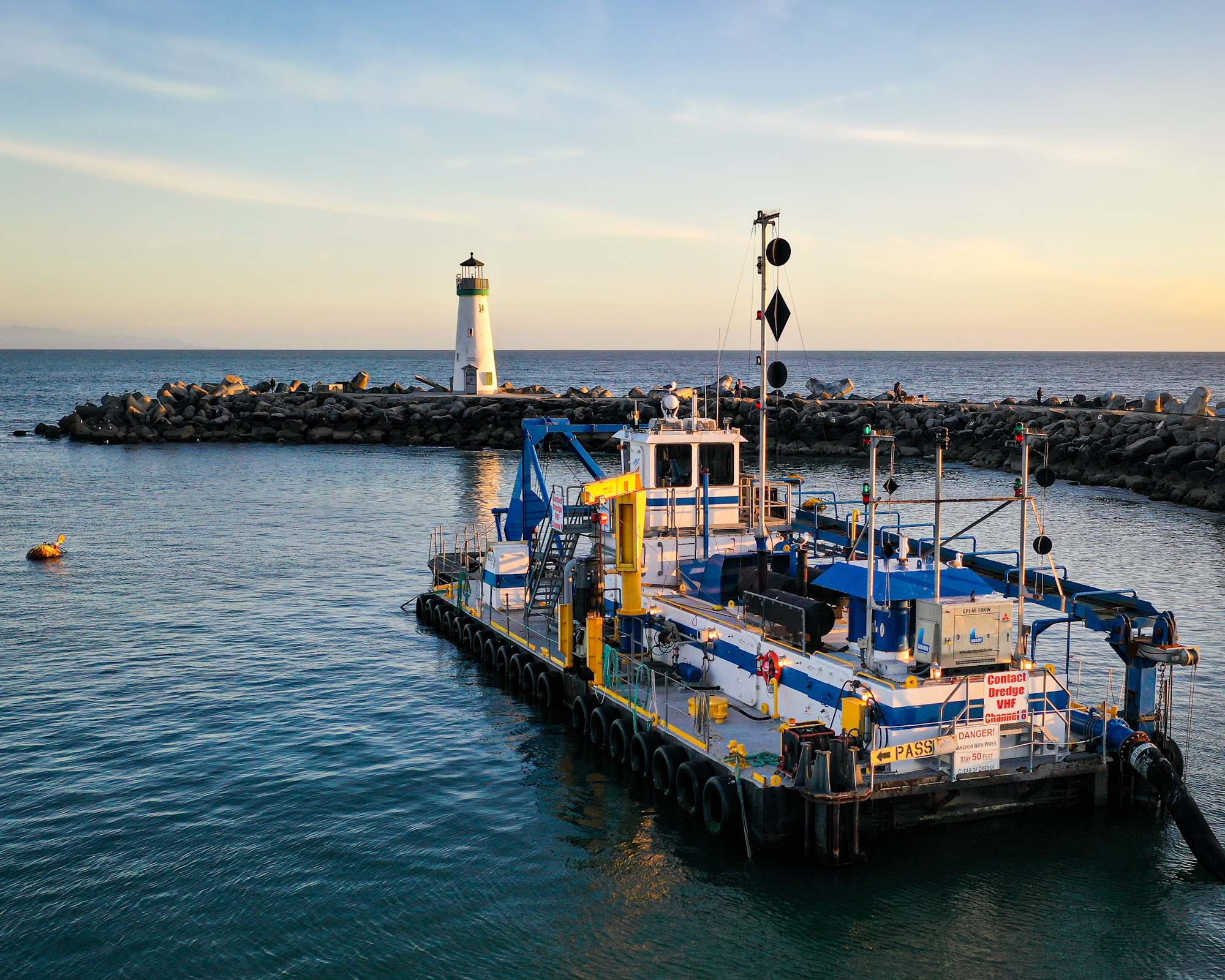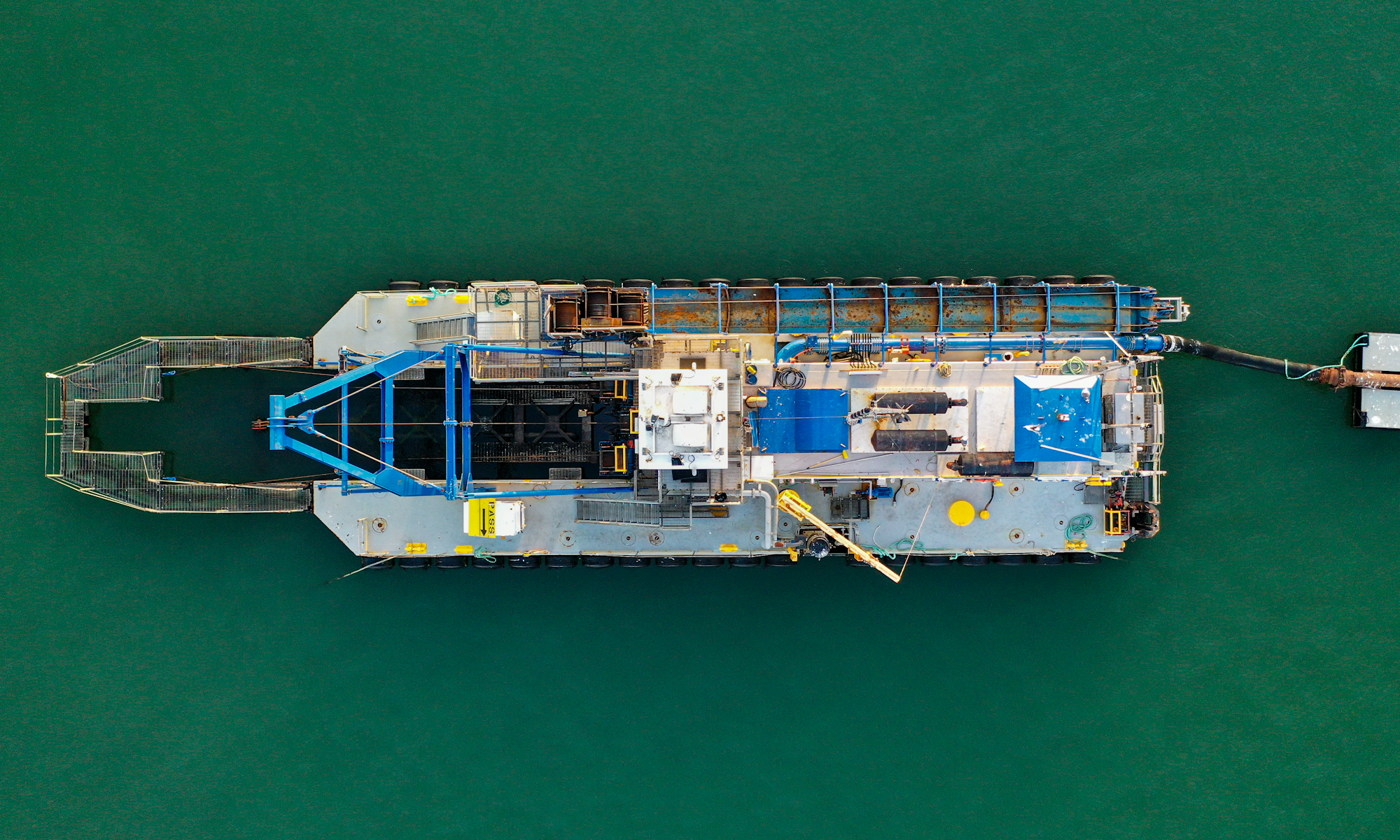Dredge Operations
The Santa Cruz Port District dredges the harbor channel between November 1 and May 1 of each year. During this time, the Port District may elect to direct the sediments from its dredging operation in the beach zone area.
For any questions regarding the District’s dredge operation, please contact the harbor office at (831) 475-6161.

The Port District’s dredging operation occurs between November and April of each year. This has occurred each year since the harbor was first constructed in 1964. Sand, which moves downcoast through the process of littoral drift, becomes trapped in the harbor entrance channel. The dredging operation picks up the sand deposited in the entrance and places it downcoast, bypassing the east jetty, so it can continue to provide replenishment and protection downcoast of the harbor.
The dredge crew utilizes three types of disposal methodologies, including surf-line disposal. Surf-line disposal is most often utilized to replenish the beach with high quality sand or when the District’s offshore pipeline is unavailable. Disposal of dredged material in the nearshore achieves multiple objectives, which include replenishing beaches and surfing areas downcoast of the harbor with sand, protecting bluffs, roadways, and public utilities, as well as park assets on Twin Lakes State Beach and Harbor Beach. Sand is an important resource, and the dredging bypass system returns the sand into the system where it can provide a soft sand buffer, and reduce the need for hard-facing cliffs and other infrastructure in the coastal zone.
In accordance with regulatory permits issued and reviewed by various agencies, including the California Regional Water Quality Control Board, the California Coastal Commission, the Monterey Bay National Marine Sanctuary, and the US Army Corps of Engineers in consultation with the Environmental Protection Agency, the Port District performs all required physical, chemical, and biological analyses on material proposed to be dredged on an annual basis. Regulators from each agency review the sampling and analysis data and deem the sediment as suitable for aquatic disposal…simply stated, the material is clean, beach quality sand. Though the sand and seawater appear dark during disposal operations, it is not noxious sludge, which is why our beach area consistently attains A+ ratings.
In addition to the strict testing requirements, the Port District is also required to monitor Hydrogen Sulfide (H2S) emissions during all dredge operations in accordance with permit requirements set forth by the Monterey Bay Air Resources District. H2S emissions associated with the dredge operation are typically caused by organic material (kelp, seaweed, seagrasses, etc.) becoming entrained in the sand. A stationary monitoring system, including a vehicle mounted H2S monitor is positioned adjacent to the dredge monitoring tower (near 5th Avenue). Restrictions on nuisance level odor limitations remain at 1/3 of the State’s nuisance level.
If there are any questions regarding the District’s dredging operation, please contact Administrative Services Officer Renee Ghisletta at (831) 475-6161, ext. 22 or rghisletta@santacruzharbor.org.
The 2024-25 dredge season concluded on April 30, 2025. Kudos to the dredge crew for another successful dredging season! The crew has begun to demobilize Twin Lakes and other dredge equipment in preparation for off-season maintenance work. Twin Lakes is tentatively scheduled to be moved to its off-season mooring on May 30, 2025.
Prior to transiting the entrance, mariners are still advised to check tide and weather conditions, view the entrance sounding online, and know what your vessel draws. Entrance soundings will be updated periodically during the off-season and posted on the District’s website.
Last dredge season, the crew made significant progress deepening the north harbor slips and fairways. As a result, north harbor dredging is not planned for the 2024-25 season.
Why We Dredge
Dredging of the harbor is required because of the constant easterly movement of sand along our coast and thus, across our harbor entrance. Such movement is generated by the ongoing forces of waves and currents. The amount of material moved and deposited is directly proportional to the severity of current and wave conditions. This constant movement of masses of sand is termed littoral drift.
Sand indicated by orange dotted areas, is carried down the San Lorenzo River and thence moved down-coast by wave and tidal action called littoral drift. Constantly moving, the sand mass builds up against the west jetty and flows around it, shoaling the Santa Cruz Harbor entrance channel. Impeding sand is then dredged from the entrance channel and deposited in the inter-tidal zone where the existing littoral drift carries it down-coast, nourishing those beaches east of the Santa Cruz Harbor entrance.
The Danger of Shoaling

Because of sand incursion at the mouth of the harbor, it is essential that an annual dredging effort be maintained to assure sufficient depth at the harbor entrance to permit the safe passage of vessels transiting the entrance. Shoaling conditions caused by littoral sand drift produce dangerous and unpredictable breaking wave formations at the harbor’s entrance. These breaking waves are extremely hazardous to incoming, and outgoing vessels and pose a particular danger to individuals walking on either of the jetties.

